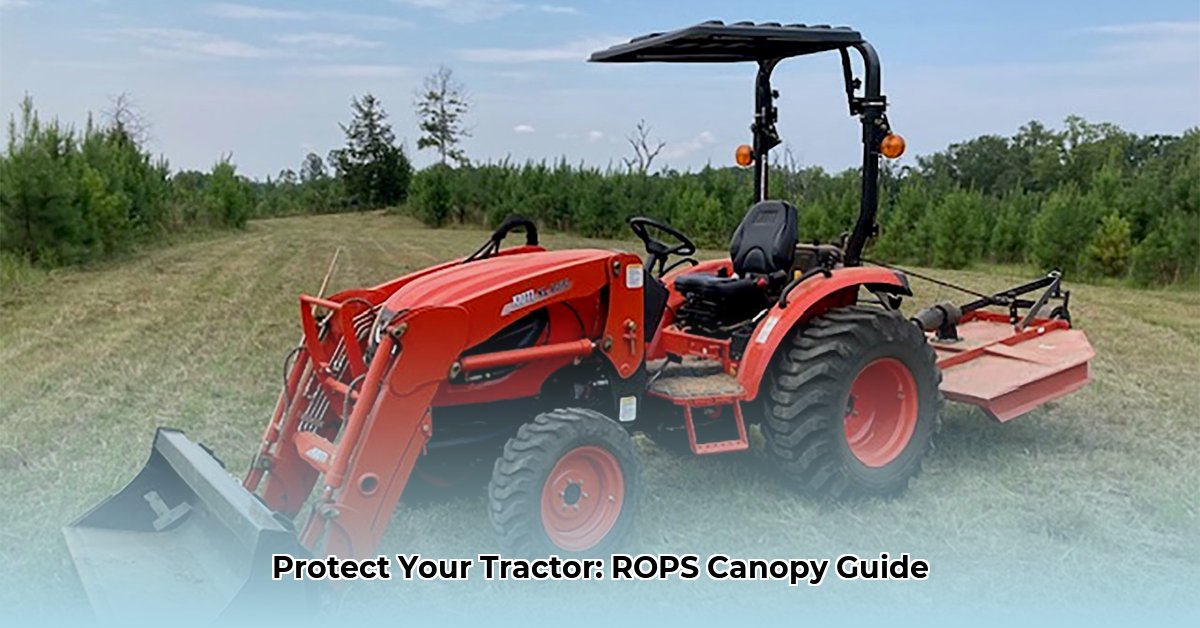
Understanding Your Options: Types and Features of Tractor ROPS Canopies
Choosing the right Rollover Protective Structure (ROPS) canopy for your tractor is a crucial decision impacting your safety and comfort. Several types of canopies offer varying levels of protection and features. Let's explore the main categories to help you make an informed choice.
For more information on tractor supply canopies, check out this helpful resource.
Basic ROPS Canopies: These provide essential overhead protection, shielding you from falling objects and offering a degree of rollover protection. They are typically the most affordable and easiest to install. However, they offer minimal protection from the elements.
Partial Enclosure ROPS Canopies: These offer a balance between protection and cost. They provide more shielding from sun, rain, and dust than basic canopies with some added side protection. While offering increased weather protection, they still maintain reasonably good visibility.
Fully Enclosed Cab ROPS Canopies: These provide the highest level of protection against the elements, debris, and noise. Imagine a small, climate-controlled environment integrated into your tractor. They are the priciest and heaviest option, and may slightly reduce overall visibility.
The table below summarizes the key differences:
| Canopy Type | Key Advantages | Potential Drawbacks | Approximate Price Range (USD) |
|---|---|---|---|
| Basic ROPS | Affordable, lightweight, easy installation, simple maintenance | Minimal weather protection, limited comfort | $500 - $1,500 |
| Partial Enclosure ROPS | Increased weather/debris protection, better visibility than fully enclosed | Higher cost than basic, less protection than a full enclosure | $1,500 - $3,000 |
| Enclosed Cab ROPS | Maximum protection from elements and debris, enhanced comfort | Highest cost, potentially heavier, might reduce visibility | $3,000 - $8,000+ |
Isn't it crucial to weigh the benefits against your specific needs and budget? Choosing the right canopy significantly impacts your safety and operational efficiency.
Navigating Safety Standards and Regulations
Prioritizing safety is paramount. Before purchasing any ROPS canopy, verify its compliance with relevant safety standards. Organizations like ISO (International Organization for Standardization) and ANSI (American National Standards Institute) define these standards. Operating a tractor with a non-compliant canopy exposes you to unnecessary risks. Check local regulations to ensure compliance before installation. Your safety depends on it. Did you know that non-compliant ROPS canopies account for a significant percentage of preventable tractor-related injuries?
Installation and Maintenance: A Step-by-Step Guide
Correct installation is critical for ROPS canopy effectiveness. While specific steps vary, the following provides a general guideline:
Consult Manufacturer Instructions: Always start with the manufacturer's instructions for detailed guidance. This is essential for safe and proper installation.
Prepare Tractor and Workspace: Clean the mounting area thoroughly and gather all necessary tools. A clean workspace enhances precision and safety.
Secure Canopy Mounting: Carefully attach the canopy to designated mounting points. Ensure all bolts and fasteners are correctly positioned and tightened according to the instructions.
Verify Stability: Thoroughly inspect the canopy for stability after installation. Gently test it to confirm secure attachment.
Regular Inspections: Regularly check bolts and connections for tightness and inspect for any wear or damage. Address any issues promptly.
Making the Right Choice: Key Considerations
Choosing the best ROPS canopy involves several factors:
Tractor Compatibility: Ensure compatibility with your tractor model and year to avoid safety compromises.
Budget: Establish a budget before you begin your search. Prices vary significantly depending on features and type.
Desired Features: Determine the level of protection needed—basic overhead protection or comprehensive weather protection?
Climate and Conditions: Consider local climate and working conditions. A full enclosure is ideal for harsh weather, whereas a basic canopy might suffice for dry conditions.
Dispelling Common Myths: Understanding ROPS Canopies
Several misconceptions surround ROPS canopies. One common concern is reduced visibility. While some designs might slightly affect peripheral vision, the added safety far outweighs this minor drawback. Another misconception is that ROPS canopies are only necessary for large farms or commercial operations. Remember, your safety should be a priority regardless of the size or type of farming operation.
Future Trends in ROPS Technology
ROPS technology is constantly advancing. Expect lighter, stronger materials, improving durability while minimizing weight. Integration with other tractor safety systems and the incorporation of advanced features and automation are likely on the horizon. Research continues to explore materials and designs that will bring enhanced safety and comfort.
Three Pivotal Points:
- Choosing the right ROPS canopy significantly impacts both operator safety and productivity.
- Always verify that any ROPS canopy meets all relevant safety standards for your region.
- Regular maintenance and inspections are essential to ensure the continued effectiveness of your ROPS canopy.
This guide empowers you to make an informed decision, ensuring your safety on the farm. Remember, investing in a quality ROPS canopy is an investment in your well-being.